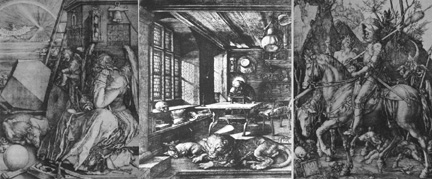
According to a google cache of http://d.whyville.net/smmk/whytimes/article?id=75:
"... Durer was born May 21, 1471, in a small village outside of Nürnberg, Germany. He was the third son of Albrecht Durer and Barbara Holfer. He was one of eighteen children ... His father's family came from Hungary ... the family name was Ajtos which means "door" in Hungarian. When Durer senior and his brothers came to Germany they chose the name Turer which sounds like the German "Tur" meaning door. ... His father ... died in 1502 and Durer was left to care for his sick, and nearly blind, mother. ...".
According to an alchemylab web article by John Read:
"... Durer (1471-1528) ... was particularly skilled in drawing on the block for the wood-cutter and in engraving on copper with his own unsurpassed hand. In 1513 and 1514 he wrought three engravings on copper that will rank for all time among the world's select masterpieces of this form of art. These were ...
"Melencolia" (1514). ... "St. Jerome in his Study" (1514), ... and ... "The Knight " (1513) ...". (images from web museum web pages)

Old Dog or Mature Dog Young Dog Newborn Lamb Lion Salamander

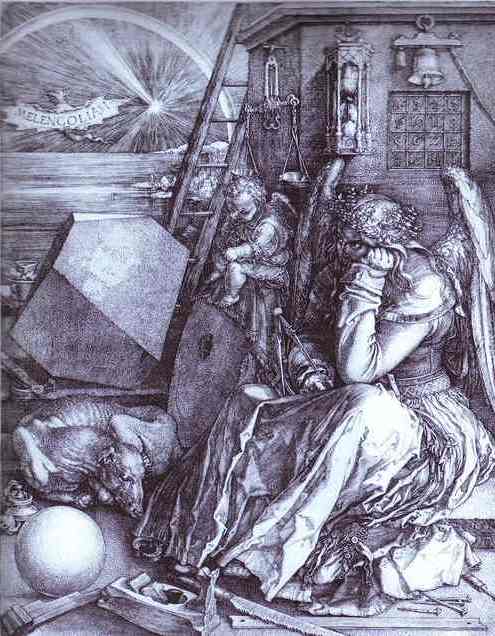
According to an alchemylab web article by John Read:
"... The rainbow, seen in the background, was the alchemist's favorite symbol for the colors that were held to appear, in a definite sequence culminating in red ...
... alchemical apparatus ... of Durer's design [included] ... the crucible ... the saw and plane and the hammer and nails ... Sophic Sulfur, one of the two final ingredients of the Philosopher's Stone, and ... second ingredient, Sophic Mercury, was sometimes ... shown balancing ... in a pair of scales ...
The seven-runged ladder ...[of] Jacob ... is another ... alchemical symbolism, the rungs representing ... the associated heavenly bodies ...
The polyhedron lying beside the foot of the ladder ... may be an image of the Philosopher's Stone ... the ... Stone of Saturn ... One of the elements of Saturnine mysticism is measurement, typified by the compasses, balance, and hour-glass ...".
... The number four is emphasized in the magic square ...[
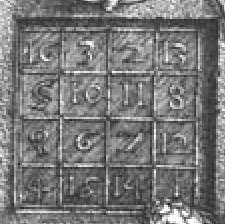
]... shown so prominently in ...[ MELENCOLIA I ]... This magic square ... shows the date of the engraving (1514) in the middle cells of the bottom row. Similar magic squares of the orders three through nine were constructed by Durer's contemporary, Cornclius Agrippa, and assigned to Saturn, Jupiter, Mars, Sol, Venus, Mercury, and the Moon. ...".
According to a Magic Square web page:
"... Cornelius Agrippa (1486-1535) joined the seven known planets with these seven Magic Square:
According to a Web Gallery of Art web page:
"... Durer's greatest achievement in printmaking were the three engravings of 1513-14, regarded as his masterpieces. Melencolia I is by far the most complex of the three master engravings. The winged genius, representing the figure of Melancholy, rests her head on her hand, in a reflective pose, and holds a compass. Around her are geometric shapes, including a sphere and a giant polyhedron, along with scattered woodworking tools. The tools are drawn from the field of measuring and building, in other words, architecture. The rhomboid and sphere represent geometry, the science of measurement and numbers upon which all arts are based. On the wall of the building hang a bell, an hourglass, scales and a magic square of 16 numerals (with each line adding up to 34). A dog sleeps at Melancholy's feet and a cherub sits astride an upturned millstone. A bat-like creature holds up the inscription ... Melencolia I ...".
David Finkelstein noticed the peculiar spelling of MELENCOLIA and realized that it could have been so spelled in order to make an anagram, such as:
= LIMEN (Latin for threshhold, door, gate) + COALE (Latin for sustain or keep) + I =
= I the Gate Keeper
Such an anagram for MELENCOLIA I would mean that the final I is NOT the Roman Numeral I indicating the first of a possible series of engravings.
The Gematria value of melencolia is the Fermat prime number 257 = 256 + 1 when evaluated as follows: m - mu - mem = 40 e - epsilon - he = 5 l - lambda - lamed = 30 e - alpha - aleph = 1 n - nu - num = 50 c - kappa - kaph = 20 o - omicron - a'ayin = 70 l - lambda - lamed = 30 i - iota - yod = 10 a - alpha - aleph = 1 TOTAL = 257 = 256 + 1 subtotal for limen = 135 = 27 x 5 subtotal for coale = 122 = 2 x 61
Eddington got 136 by
starting with 2x2 = 2^2 = 4 = 1 + 3 (nails in Melencolia I)
and then separating pure from mixed products:
(1 + 3 ) x (1 + 3) =
= 1x1 + 3x3 (pure) + 3x1 + 1x3 (mixed) =
= 10 + 6 = 16 4x4 = 2^4
(10 + 6 ) x (10 + 6) =
= 10x10 + 6x6 (pure) + 6x10 + 10x6 (mixed) =
= 136 + 120 = 256 = 16x16 = 2^8
The 120 = half of the 240 small panes windows of St. Jerome's study
The 136 = 16x17/2 = Jupiter Magic Square in Melencolia I
The 256 = Cl(1,7) D4 Clifford algebra of D4-D5-E6-E7-E8 VoDou Physics
= the 256 Odu of IFA
The large polytope
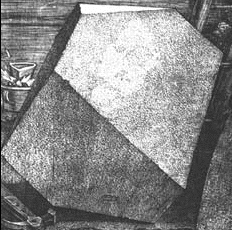
is a transformation of a cube. To make it, start with a cube whose long diagonal is vertical
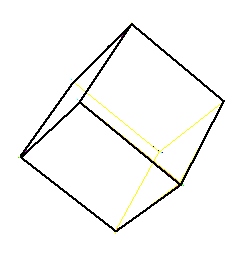
Note that it has 1+3+3+1 = 8 vertices
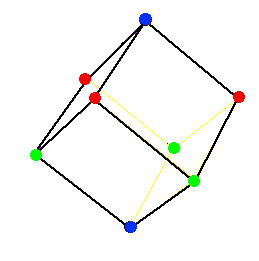
and that if the middle 3+3 = 6 were projected to the ground, they would form the outer vertices of a Mogen David
/\ ____/__\____ \ / \ / \/ \/ /\ /\ /__\____/__\ \ / \/
of two intersecting triangles.
Now, stretch the cube vertically by a ratio of 5:4
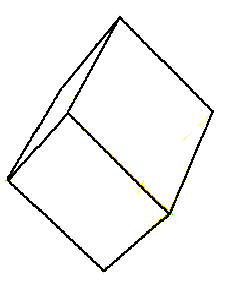
"... Albrecht Durer (1471-1528), one of the first masters of perspective, felt that geometry was the right foundation for all painting and decided to "teach its rudiments and principles to all youngsters eager for art." Indeed, in the 16th century his four volumes of Unterweisung were meant to be understood by artists and artisans rather than mathematicians. Through this treatise, Durer introduced a type of "workshop geometry"... to other artisans of the day. Unterweisung is marked by its almost complete lack of mathematic proofs even though Durer consulted continually with geometricians. He felt artists, who created with their hands required a treatise that could provide an experimental, experiential approach, one that could be drawn on by using simple tools. It would be more accessible than an abstract treatise filled with mathematical calculations. Durer's investigations into depicting animate forms such as the human figure and plant life led him to write "The Theory of Curves" as part of this series of treatises on art which influenced generations of artists. Even without calculations and abstract logic, Durer's Unterweisung influenced scientists like Kepler and Newton as well as the artists for whom he wrote the treatise.Durer developed a "grid" through which a three-dimensional scene could be depicted with accuracy on a flat plane. A linear grid with its verticle and horizontal lines, however was far too simple. Durer then created a newer method of constructing polygons into tilings which filled space on the plane, similar to the tilings that were seen in Islamic decoration. Durer was familiar with Islamic tilings based on regularly repeating forms of the square and triangle. Since Durer's art problem was depicting the curves of animate objects, the right angles and triangles of ordinary grids were too rigid to contain the unique curves of a leaf, a blade of grass, human breasts or buttocks. So he developed a new series of grids or "tessellations" giving special emphasis to "quadratura circuli" and the construction of polygon tilings which carried the special property of five-fold symmetry. His tilings included the pentagon (five-sided figure), decagon (ten-sided figure), enneagon (nine-sided figure) and others. ... He studied polyhedra by using "nets." These nets or tessellations could be cut and folded along prescribed lines and joined at their edges to form the regular and semi-regular polyhedral solids.
Durer's method, different than geometers of the day was to create these polygons not by mathematical calculation but by a working method whereby the "opening of the compass remains unchanged." Durer's fivefold angular figures closely approximated the arcs of curves but were drawn without calculations. He would superimpose these "tracery patterns" atop his artistic depiction of natural forms to create the proper classical curves of animate life. His fivefold tessellations allowed more freedom in depicting such curves. Durer eventually abandoned the superposition of the compassbecause such classical perfection was not found in the organic undulation of nature. Interestingly, modern crystallographers have returned to Durer's quasi-periodic tilings to understand the fivefold symmetrical x-ray diffraction patterns of recently discovered quasicrystals, crystals which have defied the known rules of crystallography. Although brought about by the need to depict the curves of nature, Durer was able to create a series of tessellations that depicted the fivefold symmetry of structures on the molecular level more than four centuries before they were found to exist. ...".
Now, truncate the top and bottom vertices by cutting horizontal slices at the midpoints of the edges leading from them
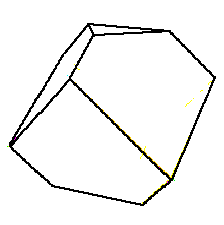
and you have Durer's Polytope of Science and Reason through which the light of the Heavenly Sun is seen to have the Symmetries of the Perfect Sphere as described by Clifford Algebras and their Rotation/Reflection Spin Groups.

The animal between Durer's Polytope and the Perfect Sphere is seen by some as the Dog of St. Jerome's Study and of the Knight, Death and Devil at an older age, and by others as a Newborn Lamb into which the Lion of St. Jerome's Study was transformed.
David Finkelstein noticed an almost sublimenal image of woman's face in Durer's polytope
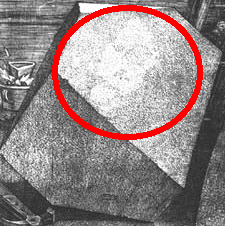
and identified her as Durer's mother, who had recently died when the engraving was done. To me, it looks like an image of Durer's mother in heaven as a beautiful young woman, before she had born 18 children.
According to an EESE web page in 1602, about 88 years after Durer engraved MELENCOLIA I in 1514, Jan Wierex made a copy of it with some alterations, including omission of the flourish between MELENCOLIA and I.
David Finkelstein noticed that the Jan Wierex copy also modified the image in the face of Durer's polytope. To me, it looks like Jan Wierex defaced the image of Durer's mother and added a bearded man.
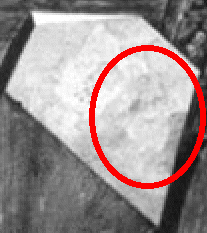
To the right of Durer's Polytope is a Wheel
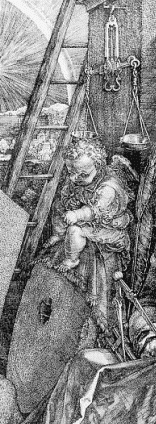
on which a Cherub sits. According to a jewishencyclopedia web page: "... The soul announces the affairs of man to the angel, the angel to the cherubim, the cherubim to God ... God is described as riding on the cherubim and ... cherubim ... guard the way of the tree of life ... and Ezekiel describes the ... ... ofanim ("wheels") ... as heavenly beings who carry God's throne. ...". According to a google html cache of a Dumbarton Oaks Papers, No. 55, web page: "... Origen believes that, in order to enter paradise, all souls must pass through the flaming sword of the cherub that stands guard outside the gates of Eden ... If the soul has preserved the grace of baptism, its passage through these gates is relatively painless. If not, it undergoes a purgatorial "baptism of fire." ...". In MELENCOLIA I, Durer shows the Cherub after carrying Jerome/Durer from Earthly Life to Heaven using the Ofanim Wheel. The Cherub has already weighed the coins/deeds of Jerome/Durer in the Libra Scales, and found them good for passage to Gan Eden/Heaven without the need for purgatorial fire of Gehinnom ( see Talmud Bavli / Tractate Chagigah, The Gemara, The ArtScroll Series / Schottenstein Edition, Mesorah Publications Ltd. (1999) 15b 1,5 ).
According to the Encyclopaedia Britannica, Micropaedia v. 8 (1987) 997-999: "... Origen ... Oregenes Adamantius ... b. c. 185 ... d. c. 254 ...[was]... the most important theologian and biblical scholar of the early Greek Church. His greatest work is the Hexapla, a synopsis of six versions of the Old Testament. ... The chief accusations against Origen's teachings ...[include]... spiritualizing away the resurrection of the body; denying hell, a morally enervating universalism; speculating about preexistent souls and world cycles ... At the same time there is much reason to justify Jerome's first judgment that Origen was the greatest teacher of the early church after the Apostles. ...".
David Finkelstein noticed that the Ofanim Wheel can be represent the millstone of Hamlet's Mill, the Milky Way.
According to a phoenixandturtle web page about Hamlet's Mill (1977) by Santillana and von Dechend: "... First, people will deny a thing; then they will belittle it; then they will decide that it had been known long ago. ... the origins of science had their deep roots in ... myth ... The problem of number remains to perplex us, and from it all of metaphysics was born ...
... Hamlet ... Amlodhi ...[owned]... a fabled mill which, in his own time, ground out peace and plenty. Later, in decaying times, it ground out salt; and now finally, having landed at the bottom of the sea, it is grinding rock and sand, creating a vast whirlpool, the Mael-strom ... which is supposed to be a way to the land of the dead. This imagery stands, as the evidence develops, for an astronomical process, the secular shifting of the sun through the signs of the zodiac [ precession of the equinoxes ] which determines world-ages, each numbering thousands of years. Each age brings a World Era, a Twilight of the Gods. Great structures collapse; pillars topple which supported the great fabric; floods and cataclysms herald the shaping of a new world. ... Amlodhi was identified ... from the Northland to Rome, from there to Finland, Iran, and India; he will appear again unmistakably in Polynesian legend. ...
... the "Seven Sages," as they are often cryptically mentioned in India and elsewhere. They turn out to be the Seven Stars of Ursa, which are normative in all cosmo-logical alignments on the starry sphere. These dominant stars of the Far North are peculiarly but systematically linked with those which are considered the operative powers of the cosmos, that is, the planets as they move in different placements and configurations along the zodiac. ... In China, Saturn has the title "Genie du pivot," as the god who presides over the Center, the same title which is given to the Pole star ... The cube was Saturn's figure, as Kepler showed in his Mysterium Cosmographicum ...
... K'uei alone had the talent to bring into harmony the six pipes and the seven modes, and Shun, who wanted to bring peace to the empire, stood by the opinion that "music is the essence of heaven and earth." ... K'uei also could cause the "hundred animals" to dance by touching the musical stone, and he helped Yu the Great, that indefatigable earth-mover among the Five First Emperors, to accomplish his labor of regulating the "rivers." And it turns out that he was not only Master of the Dance, but Master of the Forge as well ... The Yakuts claim: "Smith and Shaman come from the same nest," and they add: "the Smith is the older brother of the Shaman," ... It is the primeval Smith who made the ...great mill, called the ... Sampo ... and forged sky and luminaries in Esthonia. It is no idle fancy that the representative of the celestial smith, the King, is himself frequently titled "Smith." Jenghiz Khan had the title "Smith" ... the standard of the Persian Empire was the stylized leather apron of the Smith Kavag ... The Chinese mythical emperors Huang-ti and Yu are ... unmistakable smiths ...
... In African societies which have preserved their traditional organization the number of persons who are trained in this knowledge is quite considerable. This they call "deep knowledge" in contrast with "simple knowledge" which is regarded as "only a beginning ..." ... among the Mande peoples of West Sudan ... the drum occupied the place that the Tabernacle had in the Old Testament ...
... the equinoctial "points"... move along the ecliptic in the opposite direction to the yearly course of the sun, that is ... Taurus->Aries->Pisces, instead of Pisces-> Aries->Taurus ... the Precession of the Equinoxes ... needs to circumscribe the ecliptical North Pole ... roughly 26,000 years, during which period it points to one star after another: around 3000 B.C. the Pole star was alpha Draconis; at the time of the Greeks it was beta Ursae Minoris; for the time being it is alpha Ursae Minoris; in A.D. 14,000 it will be Vega. ... The sun's position among the constellations at the vernal equinox ... occup[ies]... each zodiacal constellation for about 2,200 years ... At [t]ime Zero ( say, 5000 B.C. ...[when]... the crossroads of ecliptic and equator coincided with the crossroads of ecliptic and Galaxy, namely in Gemini and Sagittarius ) ... the sun was in Gemini; it moved ... into Taurus, then Aries, then Pisces, which it still occupies and will for some centuries more ... the coming of Pisces was long looked forward to, heralded as a blessed age. It was introduced by the thrice-repeated Great Conjunction of Saturn and Jupiter in Pisces in the year 6 B.C., the star of Bethlehem ...
... when one finds numbers like 108, or 9 X 13, reappearing under several multiples in the Vedas, in the temples of Angkor, in Babylon, in Heraclitus' dark utterances, and also in the Norse Val-halla, it is not accident ... The tradition of Celtic Druidism was delivered not only in songs, but also in tree-lore which was much like a code. And in the East, out of complicated games based on astronomy, there developed a kind of shorthand which became the alphabet. ...
... Johannes Kepler ... was of the old order in his unremitting calculations and his passionate de-votion to the dream of rediscovering the "Harmony of the Spheres." But he was a man of his own time, and also of ours, when this dream began to prefigure the polyphony that led up to Bach. ...
... John Maynard Keynes, who knew Newton as well as many of our time, said of him: Newton was not the first of the Age of Reason. He was the last of the magicians, the last of the Babylonians and Sumerians, the last great mind which looked out on the visible and intellectual world with the same eyes as those who began to build our intellectual world rather less than 10,000 years ago. ... He regarded the universe as a cryptogram set by the Almighty ... By pure thought, by concentration of mind, the riddle, he believed, would be revealed ...
.... The treasures of Celtic tradition, of Egypt, China, tribal or megalithic India, and Oceania have barely been sampled. Nevertheless, the careful, inductive application of critical standards of form along the belt of High Civilizations has been enough to show the remnants of a preliterate "code language" of unmistakable coherence. ... There were some men, surely exceptional men, who saw that certain wondrous points of light on high in the dark could be counted, tracked, and called by name. ... Their strange ideas, inscrutable to later ages, were the beginnings of intellect, and in the course of time they grew into a koine, or lingua franca, covering the globe. This common language ignored local beliefs and cults. It concentrated on numbers, motions, measures, overall frames, schemas, on the structure of numbers, on geometry. ... the sequence leads from words to numbers, and then even beyond the idea of number to a world where number itself has ceased to exist and there are only thought forms thinking themselves. ...".
If you were to stand on the flat triangle top of Durer's polytope
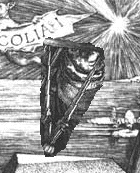
you would see that the angle from the zenith to the sun is the same as the 30 degree angle of the compass held by the angel. Note that the view is looking down on the sea and the countryside, as it is the view from the City of God
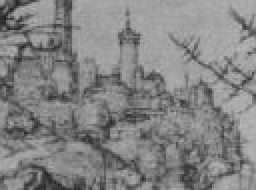
that is shown in the background of the Knight, Death and Devil. A similar City of God was shown by Durer in his 1519 engraving St. Anthony
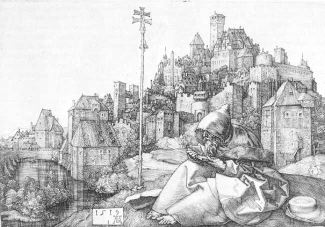
Note that although St. Anthony is near the Heavenly Summit of the City, he is still studying and learning, like St. Jerome in his Study. According to a euroweb web page: "... St Anthony (ca. 250-350 A.D.) was the first Christian monk. He lived in Egypt and loved poverty, piety and scholarship. The traditional rendering of this saint shows him in the desert beset by fantastic creatures ... But Dürer chose to picture him in a ... cityscape taken over from an entirely different subject, the drawing Pupila Augusta which Dürer had laid aside many years before. The composition is almost cubistic in concept. The contours of saint and scene correspond. During this year Dürer experimented with "cubistic" figures and faceted faces, which like St Anthony seem to have been put together block by block. ...".
(image from a web museum web page)
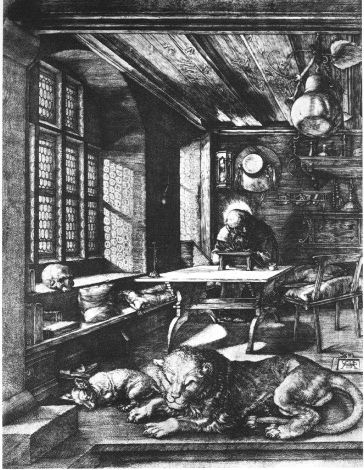
According to a euroweb web page:
"... St Jerome in his Study is stressing the contemplative rather than the active aspect of Christian life. The engraving shows the translator of the Bible deep in thought at his lectern, with the figure of the saint illuminated by sunlight streaming through the window panes into the cosy room. In front of St Jerome are the resting figures of his faithful lion and dog. A skull on the windowsill and an hourglass above the saint are reminders of the transience of life. ... Durer placed particular emphasis on the subtle differentiation of the material qualities of the objects, and the depiction of the interior according to the laws of central perspective, the converging lines of which terminate in the space to the right of the figure of the saint. The design is based on an exact plan of perspective. A certain degree of distortion is due to the fact that the vanishing point is placed close to the margin instead of the centre. This ... can be observed in other works by Durer ...".
The Pumpkin hanging from the ceiling represents Halloween - All Saints Day - All Souls Day, the time of transition from Earthly Life to the Heavenly City of God, the light of which shines through the windows of St. Jerome's Study.
The Gematria value of St. Jerome is the prime number 1023 = 1024 - 1 = 2^(2x5) - 1 = 4x256 - 1 when evaluated as follows: S - shin = 300 t - tau = 400 J - gamma - gimel = 3 e - epsilon - he = 5 r - resh = 200 o - omicron - a'ayin = 70 m - mu - mem = 40 e - epsilon - he = 5 TOTAL = 1023 The 1024 = Cl(2,8) D5 Clifford algebra of D4-D5-E6-E7-E8 VoDou Physics
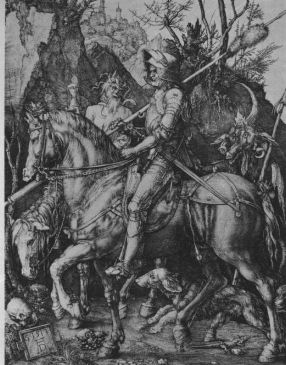
According to a euroweb web page:
"... Knight, Death and the Devil, also known as The Rider, represents an allegory on Christian salvation. Unflustered either by Death who is standing in front of him with his hour-glass, or by the Devil behind him, an armoured knight is riding along a narrow defile, accompanied by his loyal hound. This represents the steady route of the faithful, through all of life's injustice, to God who is symbolized by the castle in the background. The dog symbolizes faith, and the lizard religious zeal. The horse and rider, like other preliminary studies made by Durer, are derived from the canon of proportions drawn up by Leonardo da Vinci. ...".
According to a hennahistory web page: "... The design vocabulary of the Berbers includes ... lizard or salamander ... seekers of the sun, the human soul seeking the light ...".
The Gematria value of Knight, Death (Mort), and Devil is 64
when evaluated as follows:
K - kappa - kaph = 20
M - mu - mem = 40
D - delta - daleth = 4
TOTAL = 64
The 64 = Cl(2,4) Clifford algebra of Segal Conformal Gravity
= the 64 hexagrams of the I Ching
Here is a Key from a web page on Gematria for Greek and Hebrew:
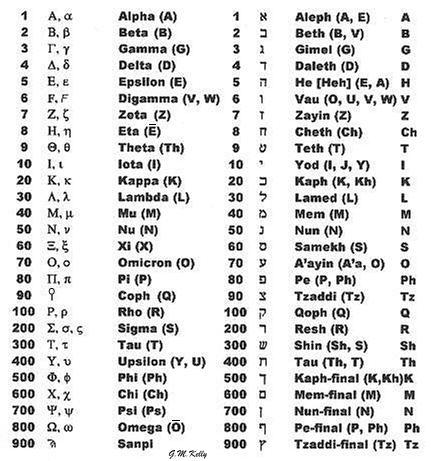
... Here is a pdf version of this 11 July 2004 web page / paper by Frank Dodd (Tony) Smith, Jr.